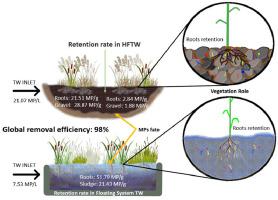Water Research ( IF 11.4 ) Pub Date : 2023-05-21 , DOI: 10.1016/j.watres.2023.120106 Darío Calzadilla Cabrera 1 , Qintong Wang 2 , Miguel Martín 1 , Nuria Oliver Rajadel 3 , Diederik P L Rousseau 2 , Carmen Hernández-Crespo 1

|
Treatment wetlands (TWs) are an efficient technology for removing microplastics (MPs) from wastewater, according to previous studies. This study investigates the dynamics and fate of MPs in two wastewater treatment plants (WWTPs) using TWs, one with horizontal subsurface flow (HF) and another with a floating plant system (FS). Special attention is paid to the retention produced in the sludge and the role of macrophyte roots. The abundance of MPs in the influent to the WWTPs was on average 20.3 ± 0.85 MP/L and 8.4 ± 1.13 MP/L in HF and FS respectively, while the effluent had 0.58 ± 0.07 MP/L and 0.17 ± 0.06 MP/L, thus giving overall efficiencies of 97.42% and 98.13%, respectively. In the HF wetland, sludge samples near the inlet and the outlet were taken, distinguishing between sludge adhered to gravel and sludge attached to roots. In the floating macrophytes, sludge samples from secondary and tertiary treatments were taken. The results indicate that roots play a significant role in MPs retention. In the HF wetland, the complex formed by roots and gravel attached more MPs than gravel alone in the final zone of the wetland. In the FS, roots retained a significant quantity of MPs, both in the secondary and tertiary treatments, thus giving rise to a sludge less concentrated in MPs. This study aims to improve the knowledge of MPs behavior and fate in full-scale TWs, providing valuable information to enhance retention efficiency.
中文翻译:

全面治理湿地中微塑料的发生和归宿
根据之前的研究,处理湿地 (TWs) 是一种去除废水中微塑料 (MPs) 的有效技术。本研究调查了两个使用 TW 的污水处理厂 (WWTP) 中 MP 的动态和命运,一个使用水平地下流 (HF),另一个使用浮动设备系统 (FS)。特别注意污泥中产生的滞留和水生植物根系的作用。污水处理厂进水中 MP 的丰度在 HF 和 FS 中分别平均为 20.3 ± 0.85 MP/L 和 8.4 ± 1.13 MP/L,而出水有 0.58 ± 0.07 MP/L 和 0.17 ± 0.06 MP/L,因此,总体效率分别为 97.42% 和 98.13%。在 HF 湿地,采集了入口和出口附近的污泥样本,区分粘附在砾石上的污泥和附着在根部的污泥。在漂浮的水生植物中,采集了二级和三级处理的污泥样本。结果表明,根在 MPs 保留中起着重要作用。在 HF 湿地中,由根和砾石形成的复合体在湿地的最终区域比单独的砾石附着更多的 MP。在 FS 中,根部在二级和三级处理中保留了大量的 MP,因此产生了 MP 浓度较低的污泥。本研究旨在提高对全面 TW 中 MP 行为和命运的了解,提供有价值的信息以提高保留效率。在湿地的最后区域,由根和砾石形成的复合体比单独的砾石附着更多的 MP。在 FS 中,根部在二级和三级处理中保留了大量的 MP,因此产生了 MP 浓度较低的污泥。本研究旨在提高对全面 TW 中 MP 行为和命运的了解,提供有价值的信息以提高保留效率。在湿地的最后区域,由根和砾石形成的复合体比单独的砾石附着更多的 MP。在 FS 中,根部在二级和三级处理中保留了大量的 MP,因此产生了 MP 浓度较低的污泥。本研究旨在提高对全面 TW 中 MP 行为和命运的了解,提供有价值的信息以提高保留效率。









































 京公网安备 11010802027423号
京公网安备 11010802027423号